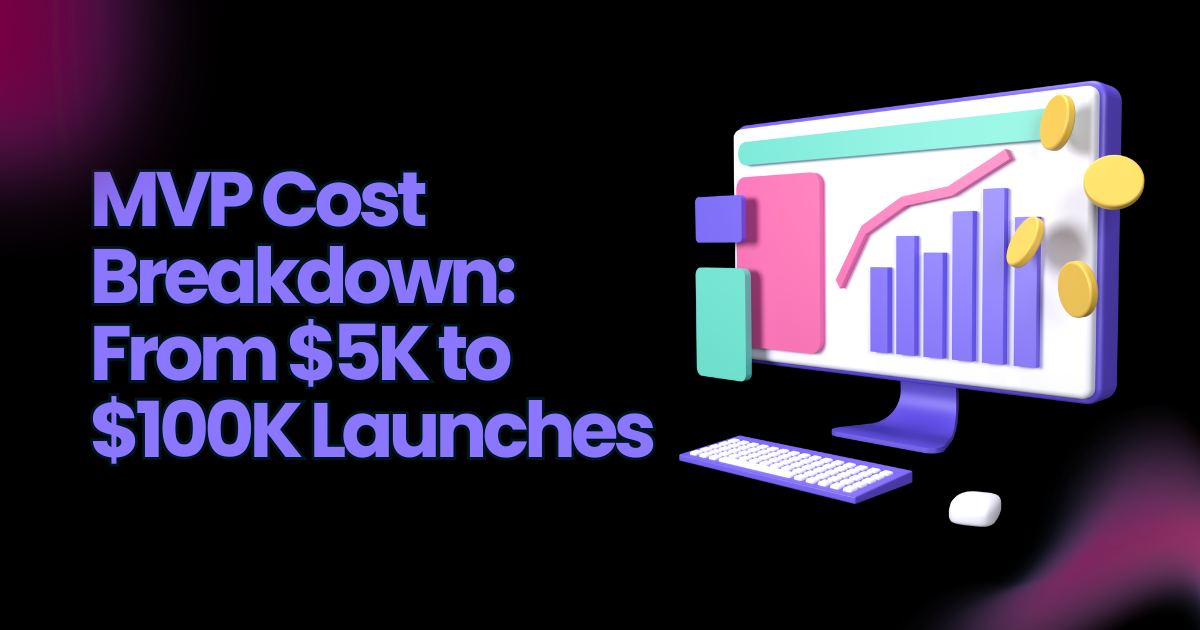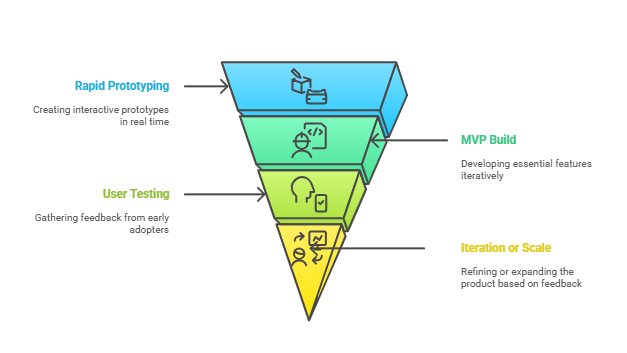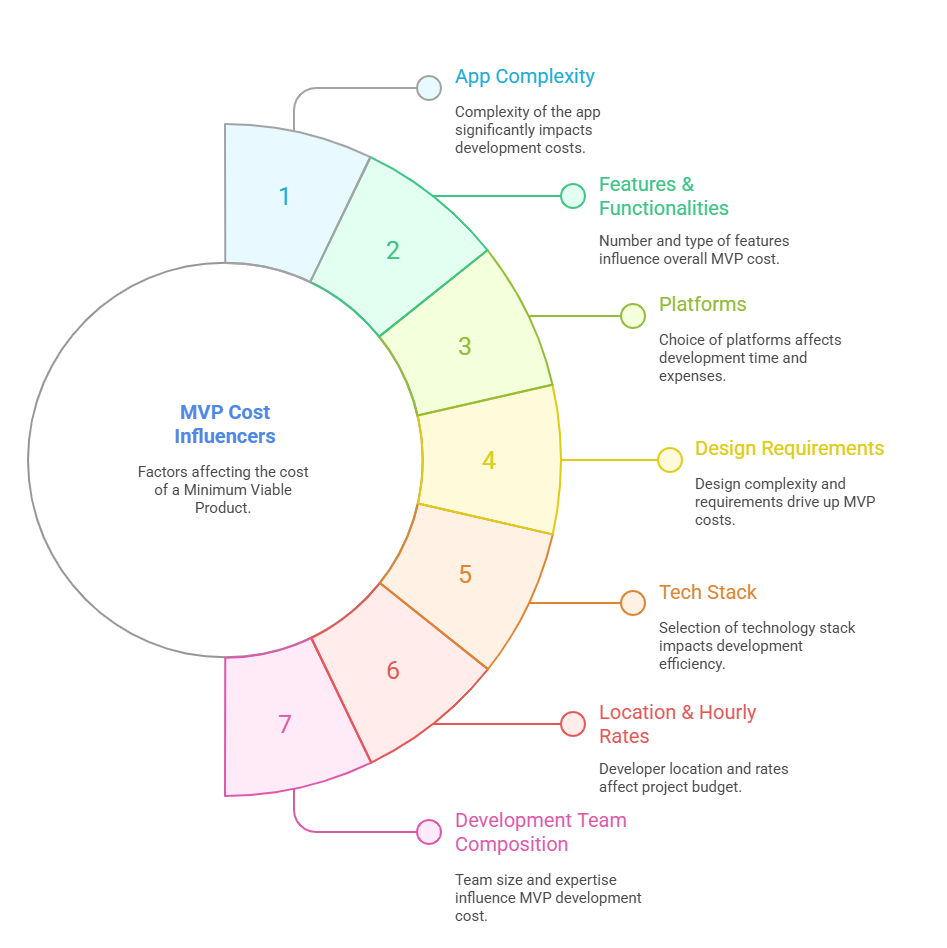
The cost to build an MVP in 2026 spans $5,000–$100,000, depending on features, platforms, and development setup.
At EnactOn, we have seen MVPs become the launchpad for global companies. Founders want the same thing: proof that their idea works, without draining budgets. MVPs are popular because they provide clarity. Instead of building everything at once, you invest just enough to learn. The question then becomes: What should I budget, and where will the money go?
MVPs remain attractive because they also create alignment. Founders, developers, and investors work around a shared minimum scope, reducing miscommunication. In 2026, when SaaS ideas face global competition, the AI-first dilemma and shorter attention spans, the speed of validation matters as much as funding. That is why the minimum viable product cost deserves close analysis.
What Is an MVP?
A Minimum Viable Product (MVP) is the earliest working version of a product designed to solve one problem and deliver usable feedback from real users.
Prototypes and wireframes are helpful for internal validation, while an MVP goes a step further. It is released into the market, used by real customers, and produces measurable data on adoption, engagement, and willingness to pay.
For founders, the cost to build an MVP comes down to building a version that balances speed and clarity. The goal is to focus on a single core feature, gather responses, and understand what users value most. This makes minimum viable product cost a question of efficiency: how fast you can learn while keeping development lean.
In 2026, MVPs remain central to SaaS and product strategy. Investors want traction before funding, and customers prefer tools that provide immediate value. A lean, focused MVP creates both early confidence for backers and clear insights for teams who want to scale.
Why Build an MVP? (Purpose & Benefits)
An MVP reduces financial risk, accelerates timelines, and improves investor confidence.

1. De-risking investment
CB Insights reports that 42% of startups fail because there is no market need. An MVP avoids this mistake by validating the need before scaling. Teams that validate cut post-launch rework signficantly, saving budget and resources.
2. Faster time-to-market
A SaaS MVP can launch in 8–10 weeks, while full products often take 6–12 months. In 2026, where competition is global and investor patience is shorter, speed matters as much as funding.
3. Investor traction
Seed funds increasingly look for user data. Founders with even modest traction from an MVP raise money 30% faster and at better terms than teams with only pitch decks.
4. User-driven iteration
An MVP creates feedback loops. Instead of assuming what users want, you test, measure, and adjust. This keeps MVP development cost tied to outcomes rather than assumptions.
Beyond these direct benefits, MVPs also improve internal decision-making. Teams avoid endless debates about features and instead focus on measurable outcomes. This shift in mindset allows startups to grow sustainably while controlling their minimum viable product cost.
Key Factors Influencing MVP Cost
The cost to build an MVP is shaped by complexity, features, design depth, technology choices, and the team. At Enacton, we have structured our MVP development services to take into account the following:

1. App Complexity
- Simple MVPs: login, one workflow, basic backend. Budget: $5k–$25k.
- Medium MVPs: multi-role logic, admin dashboard, 3rd-party integrations. Budget: $25k–$70k.
- Advanced MVPs: AI modules, real-time sync, enterprise compliance. Budget: $70k–$100k+.
Each layer of complexity adds weeks of coding and QA and hence adds to the minimum viable product cost. For example, real-time messaging can add $10k–$20k alone. Startups should carefully balance ambition with the minimum scope needed to validate demand.
2. Features & Functionalities
Features account for the largest swings in MVP development cost.
- Authentication and login: $1k–$3k
- Payment systems: $3k–$7k
- Chat/messaging: $5k–$10k
- Analytics dashboards: $10k–$15k
- AI features: $20k+
It is crucial to align features with the core user journey. Adding extras early often delays launch and reduces focus.
3. Platforms (iOS, Android, Web)
Building for Web ( ADD INTERLINK FOR MVP WEBSITE DEVELOPMENT) alone reduces MVP app cost by up to 45%. Adding iOS and Android means separate codebases or frameworks and triple the testing. Multi-platform launches make sense for products like fintech or healthcare apps where mobile adoption is non-negotiable.
A smart strategy is to test traction on Web, then expand once clear demand is visible. This approach keeps costs lean and ensures resources are invested wisely.
4. Design Requirements
- Basic template UI is cheapest.
- Custom branded UI with accessibility compliance can add $5k–$20k.
- Micro-animations and advanced UX for SaaS dashboards raise budgets further.
Well-designed interfaces also lower churn. Research shows that 88% of users do not return to apps with poor usability, which makes design a cost worth planning for.
5. Tech Stack
- Common stacks like React, Node.js, and Flutter are affordable and talent-rich.
- AI, blockchain, or AR stacks increase MVP development cost by 15–25%.
- Using modern frameworks also reduces maintenance cost over time.
Selecting a stack should align with the long-term roadmap, not just MVP launch. Choosing an obscure technology may save in the short run but increase costs later due to limited talent.
6. Location & Hourly Rates of Developers
- US/Western Europe: $80–$120/hour
- Eastern Europe: $40–$70/hour
- India: $25–$50/hour
The same MVP may cost $25,000 offshore but $75,000 in Silicon Valley. Many startups now adopt hybrid models: architect in the US, development pod in India. This balance keeps MVP app cost competitive while maintaining quality.
7. Development Team Composition
A team may include:
- Product Manager
- 1–3 Developers
- Designer
- QA Tester
- DevOps Engineer
Each role adds about $5k/month at blended rates. Larger teams shorten timelines but raise MVP app cost. Founders should decide whether speed or budget is the bigger priority.
Step-by-Step MVP Development Process
A clear MVP product development process ensures costs remain predictable and outcomes measurable.
1. Discovery (1–2 weeks)
Define market need, target users, and KPIs. Skipping discovery often doubles costs later.
2. Scoping & Road-mapping (1 week)
Feature prioritization, tech stack selection, and budget lock. At EnactOn, we freeze scope sprint by sprint to prevent overruns.
3. Prototyping (1–2 weeks)
Low-fidelity wireframes tested with stakeholders. Early validation reduces MVP development cost later.
4. Design Sprint (2 weeks)
UI kits, clickable prototypes, accessibility testing. SaaS products often require consistent dashboards and data views.
5. Development (4–12 weeks)
Agile sprints with weekly demos. Continuous integration pipelines cut deployment errors.
6. QA & Hardening (1–2 weeks)
Device testing, security checks, load testing. Teams that skip this stage often face higher maintenance bills.
7. Beta Launch (1 week)
Cloud hosting setup, onboarding of first 50–100 users, analytics instrumentation.
8. Iteration
Backlog refresh every sprint based on usage. Iteration is what keeps MVP app cost aligned with learning.
Each stage matters because skipping or rushing one creates costs later. A disciplined MVP product development process creates both financial efficiency and better user outcomes.
Average Cost Estimates for Building an MVP
The cost to build an MVP rises in layers. Simpler versions validate ideas quickly, while more complex builds introduce roles, integrations, or compliance to serve wider markets. Founders often discover that the real driver of minimum viable product cost is not the number of screens, but the level of depth needed for adoption, trust, and growth. Each stage of complexity brings clarity about what the market truly values. Industry benchmarks show MVP development cost falls into three tiers.
| Complexity | Typical Features | Cost to Build an MVP | Timeline |
| Simple MVP | Auth, single workflow, basic UI | $5k–$25k | 4–6 weeks |
| Medium MVP | 3–5 features, admin panel, APIs | $25k–$70k | 6–12 weeks |
| Advanced MVP | AI, multitenant SaaS, SOC-2 | $70k–$100k+ | 12–20 weeks |
These estimates assume blended offshore rates of about $35/hour. Onshore builds can be 2–3× higher. Founders should also expect post-launch iteration to add another 20–30% to the first-year budget.
Hidden or Additional Costs of MVP Development
What founders often forget is that MVP budgets don’t end when coding stops. Hosting, monitoring, and security are ongoing. A payment processing SaaS we built faced recurring SDK charges of nearly $400 a month for fraud detection tools. Those charges were small compared to development, but unavoidable.
Compliance costs also creep in. A health-tech startup we partnered with had to spend an additional $7,500 for HIPAA audits before onboarding its first users. None of this showed up in their initial spreadsheet.
Post-launch support is another layer. Even a lean SaaS MVP will need bug fixes and UI polish after early users start giving feedback. On average, teams should expect around 20% of the original build cost to go back into the product within the first year.
Cost-Saving Strategies for MVP Development
Founders can reduce MVP development cost by planning smartly and leveraging proven tools.
● Start with one workflow that defines value.
● Use open-source libraries and low-code solutions to save development hours.
● Launch on Web before expanding to mobile.
● Blend teams: senior architect locally, development offshore.
Every dollar saved in early builds is better used for marketing and growth. This mindset keeps MVP app cost manageable while maximizing learning.
Examples of Successful MVPs
SaaS history is filled with stories of lean builds that turned into category leaders.
● Intercom began with a small widget that allowed website owners to chat with users in real time. That narrow MVP became the foundation of a customer engagement company now serving thousands of businesses.
● Calendly launched with a single workflow: letting someone pick a free slot in your calendar. It validated in months and now supports millions of bookings.
● Figma started with a browser-based design tool that worked only in Chrome. The choice kept their MVP lightweight while proving demand for collaborative design.
● Basecamp originally released as a project management tool for internal use at a design agency. Its limited features became the exact simplicity that customers valued.
Like all successful SaaS MVPs, these MVPs looked small at the start, but each solved a core problem well enough to grow into a SaaS staple.
Common Mistakes to Avoid When Building an MVP
The most frequent errors founders make with MVPs directly increase MVP development cost and delay learning.
● Skipping customer validation: Coding before interviewing users often wastes months. At least 10–15 user conversations should precede development.
● Overloading features: Many teams think that more features equal more traction. In reality, they dilute focus.
● Neglecting QA: Basic testing avoids outages and rebuilds. Performance and security must be baked in, even for MVPs.
● Hiring based on cost alone: A cheap hourly rate with no portfolio often means higher expenses later. Always request live references.
We’ve seen founders spend double their budget correcting these mistakes. A disciplined approach reduces risk and keeps MVP app development ( ADD INTERLINK FOR MVP WEBSITE DEVELOPMENT) cost lean.
How to Choose the Right MVP Development Partner
Choosing a partner is not just about rates. A SaaS founder we supported had switched from another vendor because the previous team delivered code with no documentation and poor communication. The rework nearly doubled their MVP development cost.
The right partner offers more than developers. They bring a product mindset. When evaluating, look for:
● Live SaaS references
● Transparent sprint breakdowns
● Dedicated QA and DevOps alongside coding talent
● Clear rituals for communication
At EnactOn, we’ve learned that weekly demos build trust. Founders see progress, control costs, and can make decisions faster. It is one of the reasons 85% of our clients return for future projects.
Timeline to Build an MVP
Timelines are often misunderstood. Founders hear “MVP in four weeks” and assume that applies to every product. In reality, MVP timelines in 2026 range between 4 and 20 weeks, shaped by scope and complexity.
● Lean MVPs with one workflow and Web-only builds can be delivered in 4–6 weeks. These suit SaaS founders testing one function like task lists or meeting booking.
● Standard SaaS MVPs with 3–5 features and dashboards take 8–12 weeks. These are common for subscription tools, marketplaces, or analytics dashboards.
● Enterprise MVPs with AI modules, compliance, or multi-tenant features run 12–20 weeks. These projects often serve regulated industries and need security audits.
Timelines should always include a buffer for iteration. Early user feedback often reveals improvements that shape the product’s next sprint. Factoring in this time protects both quality and cost to build an MVP. Founders should plan buffer time for compliance, integrations, or feedback-driven iteration. Realistic timelines protect both quality and budget.
Cost To Build An MVP In 2026
The cost to build an MVP in 2026 ranges from $5k for lean builds to over $100k for advanced enterprise launches.
The purpose of an MVP is validation. A founder who spends wisely gains proof of demand, a roadmap for scaling, and data for investors. Costs remain predictable when teams prioritize features, plan iterations, and choose experienced partners.
At EnactOn, we’ve seen MVPs become category leaders by keeping development focused, aligning MVP development cost with outcomes, and launching fast without losing discipline.
